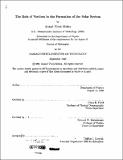The role of vortices in the formation of the solar system
Author(s)
Mehta, Anand Vivek, 1966-
DownloadFull printable version (7.956Mb)
Advisor
Glenn R. Flierl and Edmund W. Bertschinger.
Terms of use
Metadata
Show full item recordAbstract
An important part of explaining planet formation is understanding how small particles accumulate into larger bodies. Gas vortices are suggested as a mechanism to enhance the coagulation of dust particles in the solar nebula. An inviscid, barotropic, two-dimensional form of the vorticity equation is derived to study the gas flow. A pseudospectral numerical model uses this equation to calculate the evolution of the vorticity field. The calculations show that locally prograde elliptical vortices with the major axis parallel to the angular axis can persist for at least 103 years with less than 1% change in peak vorticity. The shape of the vortex depends on the strength, similar to analytical expressions for elliptical vortices in a linear shear. Stronger vortices are rounder while weaker vortices are elongated; With ratios of the peak vorticity to the background vorticity of 1.0 and 0.2, the aspect ratios are approximately 0.5 and 0.25. The vortex area is mostly constant, and the linear dimensions change as the shape changes. Two negative vortices within the same radial band tend to merge, forming a larger, stronger vortex in a few orbit periods. A random viscosity field tends to have a few strong vortices form, although not as efficiently as with merging vortices. Dust particles interact with the gas through the Stokes drag force, with the relaxation time specifying how quickly the particle velocity approaches the gas velocity. The particles tend to converge in high pressure vortices and drift out of low pressure systems. The convergence time is dependent on the vortex strength and the particle relaxation time. If the relaxation time is short compared to the period, the particles do not have an appreciable differential velocity compared to the gas, and the Stokes drag force is small. If the relaxation time is long, then the Stokes drag force is not large enough to have a significant effect. If, however, the relaxation time is of the same order as the period, so the dynamical and frictional timescales are similar, then the particles will have the shortest convergence times. This result can be seen analytically in the simple case of an axisymmetric pressure band and numerically in calculations involving the robust vortex. With a robust vortex, the convergence times are approximately 3-4 yr for relaxation times of 0.1-0.2 yr. For typical values of properties of the solar nebula, this relaxation time applies for particles with diameters of around 20 cm. Other particles, both smaller and larger, converge more slowly, but the different times result in more collisions, enhancing the coagulation of larger bodies.
Description
Thesis (Ph.D.)--Massachusetts Institute of Technology, Dept. of Physics, 1998. Includes bibliographical references (p. 117-119).
Date issued
1998Department
Massachusetts Institute of Technology. Department of PhysicsPublisher
Massachusetts Institute of Technology
Keywords
Physics